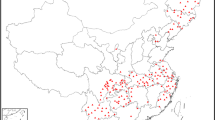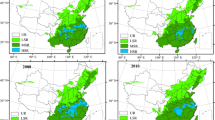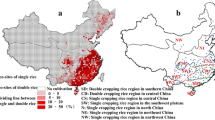Abstract
Rice (Oriza sativa) feeds nearly half of the world’s population. Regional and national studies in Asia suggest that rice production will suffer under climate change, but researchers conducted few studies for other parts of the world. This research identifies suitable areas for cultivating irrigated rice in Colombia under current climates and for the 2050s, according to the Representative Concentration Pathway (RCP) 8.5 scenario. The methodology uses known locations of the crop, environmental variables, and maximum entropy and probabilistic methods to develop niche-based models for estimating the potential geographic distribution of irrigated rice. Results indicate that future climate change in Colombia could reduce the area that is suitable for rice production by 60%, from 4.4 to 1.8 million hectares. Low-lying rice production regions could be the most susceptible to changing environmental conditions, while mid-altitude valleys could see improvements in rice-growing conditions. In contrast to a country like China where rice production can move to higher latitudes, rice adaptation in tropical Colombia will favor higher elevations. These results suggest adaptation strategies for the Colombian rice sector. Farmers can adopt climate-resilient varieties or change water and agronomic management practices, or both. Other farmers may consider abandoning rice production for some other crop or activity.








Similar content being viewed by others
References
Aggarwal P, Mall R (2002) Climate change and rice yields in diverse agro-environments of India. II. Effect of uncertainties in scenarios and crop models on impact assessment. Clim Chang 52(3):331–343
Auffhammer M, Ramanathan V, Vincent J (2012) Climate change, the monsoon, and rice yield in India. Clim Chang 111(2):411–424
Barbet-Massin M, Jiguet F, Helene C, Thuiller W (2012) Selecting pseudo-absences for species distribution models: how, where and how many 3. United Kingdom: Methods Ecol. Evol
Braunish V, Coppes J, Arlettaz R, Suchant R, Schmid H, Bollman K (2013) Selecting from correlated climate variables: a major source of uncertainty for predicting species distributions under climate change. Ecography 36:971–983
Bunn C, Läderach P, Ovalle O, Kirschke D (2014) A bitter cup: climate change profile of global production. Clim Chang 129:89–101
Busby J (1991) BIOCLIM—a bioclimate analysis and prediction system. Plant Prot. Q. (Australia)
Carpenter G, Gillison A, Winter J (1993) Domain: a flexible modelling procedure for mapping potential distributions of plants and animals. Biodivers Conserv 2:667–680
Challinor A, Watson J, Lobell D, Howden S, Smith D, Chhetri N (2014) A meta-analysis of crop yield under climate change and adaptation. Nat Clim Chang 4(4):287–291
CIESIN - Center for International Earth Science Information Network, Columbia University (2016) Gridded Population of the World, Version 4 (GPWv4): population density. Palisades, NY: NASA Socioeconomic Data and Applications Center (SEDAC). https://doi.org/10.7927/H4NP22DQ. Accessed 31 Nov 2016
Congalton R, Green K (2009) Assessing the accuracy of remotely sensed data—principles and practices. CRC PRess - Taylor & Francis Group 2:105–110
DANE – Departamentos Administrativo Nacional de Estadístico (2015) https://www.dane.gov.co
Degiovanni V, Martínez C, Motta F (2010) Producción eco-eficiente del arroz en América Latina I, Palmira: Centro Internacional de Agricultura Tropical
Dorman C (2007) Promising the future? Global change projections of species distributions. Basic Appl Ecol 8(5):387–397
Espinal C, Martines H, Acevedo, X (2005) La cadena del arroz en Colombia – Una mirada global de su estructura y dinámica. Bogota DC Ministerio de agricultura 40p
FAOSTAT (2004) Anuario estadístico de la FAO; Hoja de balance de alimentos. Organización de las Naciones Unidas para la Agricultura y la Alimentación (FAO), Roma. Available in http://faostat.fao.org/site/567/default.aspx
FEDEARROZ (2008) III Censo Nacional Arrocero. Federación Nacional de Arroceros - Fondo Nacional del Arroz, Cundinamarca. Bogotá D.C.: FEDEARROZ. http://www.fedearroz.com.co/doc_economia/Censo%20III%20-%20Libro%20General%2006%20marzo%202008.pdf
FEDEARROZ (2012) Adopción Masiva de Tecnología: Guía de Trabajo. Available from http://www.fedearroz.com.co/docs/Guia_de_trabajo_baja.pdf. Accessed 10 Oct 2017
FEDEARROZ (2017) IV Censo Nacional Arrocero. Federación Nacional de Arroceros - Fondo Nacional del Arroz. Available in http://www.fedearroz.com.co/doc_economia/Libro%20Censo%20General.pdf
Fukai S, Fischer KS (2012) Field phenotyping strategies and breeding for adaptation of rice to drought. Front Physiol 3:282
GFS (2015) Global food security, sustainable, healthy food for all. United Kingdom 20p
Global Rice Science Partnership (GRiSP) (2013) Rice almanac 4th edition. Los Baños, Philippines: International Rice Research Institute
Godfray C, Beddington J, Crute I, Haddad L, Lawrence D, James, Pretty J, Robinson S, Thomas S, Toulmin C (2010a) Food security: the challenge of feeding 9 billion people. Food Security 812–829
Godfray C, Beddington J, Crute I, Haddad L, Muir J, Pretty J, Robinson S, Thomas S, Toulmin C (2010b) Food security: the challenge of feeding 9 billion people. Science 327:818–818
Goldewijk K, Beusen A, Janssen P (2010) Long-term dynamic modeling of global population and built-up area in spatially explicit way: HIDE 3.1 20(4):565–573
Hawkins E, Smith R, Gregory J, Stainforth D (2013) Irreducible uncertainty in near-term climate projections. Clim Dyn 46(11):3807–3819
Hengl T, de Jesus M, MacMIlla R, Batjes N, Heuvelink G, Ribeiro E, Samuel-Rosa A, Kempen B, Leenars J, Walsh M, Ruiperez Gonzalez M (2014) SoilsGrids1km—global soil information based on automated mapping. PLoS One 9(8):e105992
Hernandez P, Graham C, Master L, Deborah A (2006) The effect of sample size and species characteristics on performance of different species distribution modeling methods. Ecography 29:773–785
Hijmans R, Cameron S, Parra J, Jones P, Jarvis A (2005) Very high resolution interpolated climate surfaces for global land areas Int. J Climatol 25:1965–7979
IPCC (2013) Climate change 2013: the physical science basis. Cambridge University Press, Cambridge
Jaramillo S (2017) Personal communication. Costos de producción de arroz 2017 - Jamundí Valle del Cauca, Arroz Blanquita ©. Unpublished results
Jarvis A, Rubiano J, Nelson A, Farrow A, Mulligan M (2004) Practical use of SRTM data in the tropics—comparisons with digital elevation models generated from cartographic data. Working Document, 198:1–32
Jurado J (2015) Rentabilidad económica, beneficios ambientales y sociales en el cultivo de caña de azúcar orgánica del proyecto Emenezer en el municipio de Santander de Quilichao. Universidad del Valle 1–57
Kumar A, Dixit S, Ram T, Yadaw RB, Mishra KK, Mandal NP (2014) Breeding high-yielding drought-tolerant rice: genetic variations and conventional and molecular approaches. J Exp Bot 65(21):6265–6278
Laderach P, Ramirez-Villegas J, Navarro-Racines C, Zelaya C, Martinez-Valle A, Jarvis A (2017) Climate change adaptation of coffee production in space and time. Clim Chang 141(1):47–62
Lane A, Jarvis A (2007) Changes in climate will modify the geography of crop suitability: agricultural biodiversity can help with adaptation. J SAT Agric Res 65(21):6265–6278
Lek S, Delacoste M, Baran P, Dimopoulos I, Lauga J, Aulagnier S (1996) Application of neural networks to modelling nonlinear relationships in ecology. Ecol Model 90:39–52
León L, Arregoces O (1985) Química de los suelos inundados. En E. Tascón, & E. García, Arroz: Investigación y Producción, Palmira: Centro Internacional de Agricultura Tropical 287–306
Liu C, White M, Newell G (2013) Selecting thresholds for the prediction of species occurrence with presence-only data. J Biogeogr 40(4):778–789
Lobell DB, Burke MB, Tebaldi C, Mastrandrea MD, Falcon WP, Naylor RL (2008) Prioritizing Climate Change Adaptation Needs for Food Security in 2030. Science 319(5863):607–610
López D (2014) Predicción de la futura distribución potencial de Quercus humboldtii bajo diferentes escenarios de cambio climático. Quito: Universidad San Francisco de Quito
Lundy M (2017) Personal communication. Blanquita rice processing plant in upper Cauca Valley. Unpublished results
Mackill DJ, Ismail AM, Singh US, Labios RV, Paris TR (2012) Development and rapid adoption of submergence-tolerant (Sub1) rice varieties. In Advances in agronomy (Vol. 115, pp. 299–352). Academic Press
Marquardt D (1970) Generalized inverses, ridge regression, biased linear estimation, and nonlinear estimation. Technometrics 12(3):561–612
Matthews RB, Kropff MJ, Horie T, Bachelet D (1997) Simulating the impact of climate change on rice production in Asia and evaluating options for adaptation. Agric Syst 54(3):399–425
Merow C, Smith M, Silander J (2013) A practical guide to Maxent for modeling species distributions: what it does, and why inputs and settings matter. Ecography 36:1058–1070
Nelson A (2008) Estimated travel time to the nearest city of 50000 or more people in year 2000. Joint Researc Centre - The European Commission’s In-house Science Service - Travel time to major cities: a global map of accesibility
Norman M, Pearson C, Searle P (1995) The ecology of tropical food crops. Cambridge University Press, Cambridge
O’Neil B, Kriegler E, Riahi K, Ebi K, Hallegatte S, Carter T, Mathur R, van Vuuren D (2014) A new scenario framework for climate change research: the concept of shared socioeconomic pathways. Clim Chang 122:387–400
Phillips S, Dudík M (2008) Modeling of species distributions with Maxent: new extensions and a comprehensive evaluation. Ecography 3:161–175
Phillips S, Anderson R, Schapire R (2006) Maximum entropy modeling of species geographic distribution. Ecol Model 190(3):231–259
Porter J, Dessai S, Tompkins E (2014) What do we know about UK household adaptation to climate change? A systematic review. Clim Chang 127(2):371–379
Pulver E, Jennings P, Aguiar A (2008) Revisión de la Producción y las Políticas de Arroz en Colombia. Bogotá D.C.: INDUARROZ
Ramankutty N, Foley J, Norman J, McSweeney K (2002) The global distribution of cultivable lands: current patterns and sensitivity to possible climate change. Glob Ecol Biogeogr 11(5):377–392
Ramankutty N, Evan C, Monfreda J, Foley (2008) Farming the planet: 1. Geographic distribution of global agricultural lands in the year 2000. Glob Biogeochem Cycles 22(1):GB1003
Ramirez-Villegas J, Jarvis A (2010) Downscaling global circulation model outputs: the delta method. Decision and Policy Analysis Working Paper No. 1. Decision and Policy Analysis Working Papers. International Center for Tropical Agriculture (CIAT), Palmira, Colombia
Ramirez-Villegas J, Cuesta F, Devenish C, Peralvo M, Jarvis A, Arnillas C (2014) Using species distributions models for designing conservation strategies of tropical Andean biodiversity under climate change. J Nat Conserv 22(5):391–404
Reilly J, Tubiello F, McCarl BA, Abler D, Darwin R, Fuglie K, Hollinger SE, Izaurralde C, Jagtap S, Jones J, Mearns L, Ojima DS, Paul E, Paustian K, Riha SJ, Rosenberg NJ, Rosenzweig C (2003) U.S. Agriculture and Climate Change: New Results. Climatic Change 57. https://doi.org/10.1023/A:1022103315424
Sanint L (2010) Nuevos retos y grandes oportunidades tecnológicas para los sistemas arroceros: producción, seguridad alimentaria y disminución de la pobreza en América Latina y el Caribe. En V. Degiovanni, C. Martínez, & F. Motta, Producción eco-eficiente del arroz en América Latina (Vol. I, p 3–13). Palmira, Colombia: Centro Internacional de Agricultura Tropical
Seck P, Diagne A, Mohanty S, Wopereis M (2012) Crops that feed the world 7: rice. Food Secur 4(1):7–24
Smith A, Santos M, Koo M, Rowe K, Rowe K, Patton J, Perrine J, Beissinger S, Moritz C (2013) Evaluation of species distribution model by resampling of sites surveyed a century ago by Joseph Grinell. Ecography 36:1017–1032
Stockwell D, Peters D (1999) The GARP modelling system: problems and solutions to automated spatial prediction. Int J Geogr Inf Syst 13:143–158
Taylor K, Stouffer R, Meehl G (2012) An overview of CMIP5 and the experiment design. Bull Am Meteorol Soc 93:485–498
Teng P, Caballero – Anthony M, Lassa J (2016) The future of rice security under climate change—NTS report. Centre for non-traditional security studies. Available on https://www.rsis.edu.sg/wp-content/uploads/2016/10/NTS-Report4-July2016-ClimateChangeAndRice.pdf
Tilman D, Clark M (2014) Global diets link environmental sustainability and human health. Nature. 515:518–522
Vargas J (1985) El arroz y su medio ambiente. En E. Tascón, & E. García, Arroz: Investigación y Producción 19-36. Palmira: Centro Internacional de Agricultura Tropical. Available in: http://pdf.usaid.gov/pdf_docs/PNAAU383.pdf
Warren D, Seifert S (2011) Ecological niche modelling in Maxent: the importance of model complexity and the performance of model selection criteria. Ecol Appl 21(2):335–342
Warren R, VanDerWal J, Prive J, Welbergen J, Atkinson I, Ramirez-Villegas J (2013) Quantifying the benefit of early climate change mitigation in avoiding biodiversity loss. Nat Clim Chang 3:678–682
Yao F, Xu Y, Lin E, Yokozawa M, Zhang J (2007) Assessing the impacts of climate change on rice yields in the main rice areas of China. Clim Chang 80(3):395–409
Ye Q, Yang X, Dai S, Chen G, Li Y, Zhang C (2015) Effects of climate change on suitable rice cropping areas, cropping systems and crop water requirements in southern China. Agric Water Manag 159:35–44
Yoshida, S (1981) Fundamentals of rice crop science. Los Baños: The International Rice Research Institute
Zabel F, Putzenlechner B, Mauser W (2014) Global agricultural land resources—a high resolution suitability evaluation and its perspectives until 2100 under climate change conditions. PLoS One 9(9)1:12
Zhang G, Chen L, Lei D, Zhang S (2005) Progresses in research on heat tolerance in Rice. Hybrid Rice 1:1–15
Zhang Y, Wang Y, Niu H (2017) Spatio-temporal variations in the areas suitable for the cultivation of rice and maize in China under future climate scenarios. Sci Total Environ 601:518–532
Acknowledgements
The authors thank FEDEARROZ for sharing irrigated rice location data from their phytosanitary survey. We thank CIAT and the CGIAR Research Program on Climate Change, Agriculture and Food Security (CCAFS) which sponsored this research in conjunction with Universidad del Valle. CCAFS receives support from the CGIAR Fund Donors and through bilateral funding agreements. For details please visit https://ccafs.cgiar.org/donors. The views expressed in this paper do not reflect the official opinions of these organizations. We also gratefully acknowledge Edgar Torres, Eduardo Graterol, Cecile Grenier, Santiago Jaramillo, and Jeison Mesa for the advice and discussions on the methodology and interpretation of the results.
Author information
Authors and Affiliations
Corresponding author
Additional information
Publisher’s note
Springer Nature remains neutral with regard to jurisdictional claims in published maps and institutional affiliations.
Appendix
Appendix
Changes in the key model variables of the analysis between the present climate (1950–2000) and future climate (2040–2069): accumulated precipitation between August and October (a), annual range of temperature (b), mean temperature of the wettest quarter (c), precipitation of the driest month (d), precipitation of the coldest quarter (e) and temperature seasonality (f)
Rights and permissions
About this article
Cite this article
Castro-Llanos, F., Hyman, G., Rubiano, J. et al. Climate change favors rice production at higher elevations in Colombia. Mitig Adapt Strateg Glob Change 24, 1401–1430 (2019). https://doi.org/10.1007/s11027-019-09852-x
Received:
Accepted:
Published:
Issue Date:
DOI: https://doi.org/10.1007/s11027-019-09852-x






